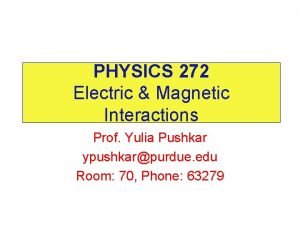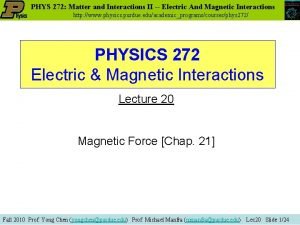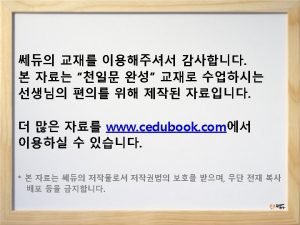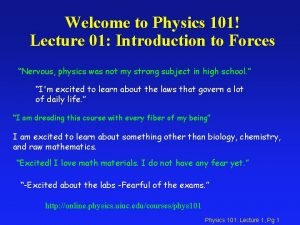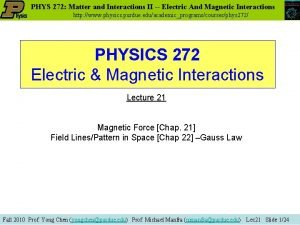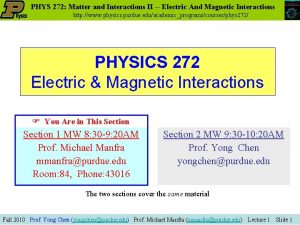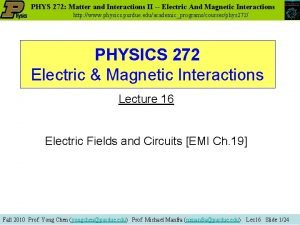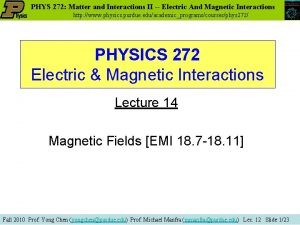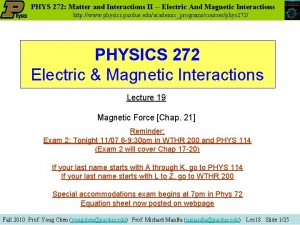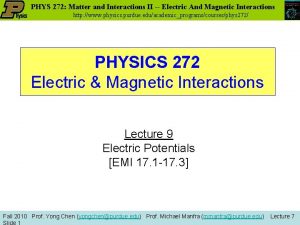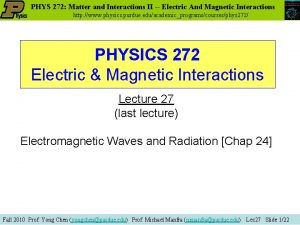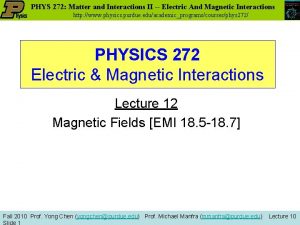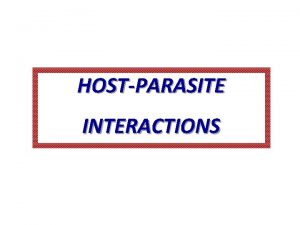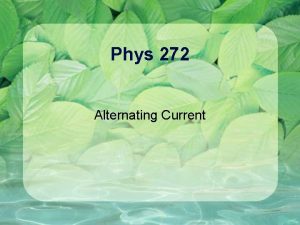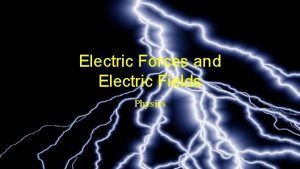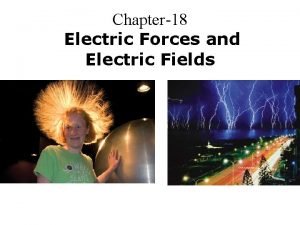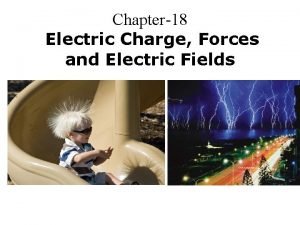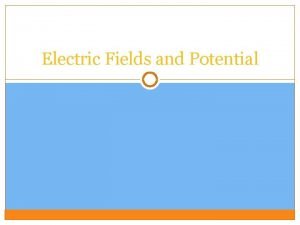PHYS 272 Matter and Interactions II Electric And

























- Slides: 25

PHYS 272: Matter and Interactions II -- Electric And Magnetic Interactions http: //www. physics. purdue. edu/academic_programs/courses/phys 272/ PHYSICS 272 Electric & Magnetic Interactions Lecture 10 Electric Potentials [EMI 17. 5 -17. 8] Fall 2010 Prof. Yong Chen (yongchen@purdue. edu) Prof. Michael Manfra (mmanfra@purdue. edu) Lecture 7

PHYS 272: Matter and Interactions II -- Electric And Magnetic Interactions http: //www. physics. purdue. edu/academic_programs/courses/phys 272/ For a conductor in equilibrium: The potential difference is zero between any two locations inside. Fall 2010 Prof. Yong Chen (yongchen@purdue. edu) Prof. Michael Manfra (mmanfra@purdue. edu) Lecture 7

PHYS 272: Matter and Interactions II -- Electric And Magnetic Interactions http: //www. physics. purdue. edu/academic_programs/courses/phys 272/ Potential Difference in Metal In static equilibrium What is E inside metal? E = 0 In static equilibrium the electric field is zero at all locations along any path through a metal. What is the potential difference (Vf – Vi)? f i The potential difference is zero between any two locations inside the metal, and the potential at any location must be the same as the potential at any other location. Is V zero everywhere inside a metal? No! But it is constant Fall 2010 Prof. Yong Chen (yongchen@purdue. edu) Prof. Michael Manfra (mmanfra@purdue. edu) Lecture 7

PHYS 272: Matter and Interactions II -- Electric And Magnetic Interactions http: //www. physics. purdue. edu/academic_programs/courses/phys 272/ Example: metal inserted into capacitor In static equilibrium -Q 1 1 mm +Q 1 Insert a 1 mm thick metal slab into the center of the capacitor. Metal slab polarizes and has charges +Q 2 and -Q 2 on its surfaces. 2000 V/m What are the charges Q 1 and Q 2? E inside metal is zero Q 2=Q 1 Now we have 2 capacitors instead of one d =3 mm V inside metal slab is zero! There is no “conservation of potential”! V = 4 V Charges +Q 2 and –Q 2 Fall 2010 Prof. Yong Chen (yongchen@purdue. edu) Prof. Michael Manfra (mmanfra@purdue. edu) Lecture 7

PHYS 272: Matter and Interactions II -- Electric And Magnetic Interactions http: //www. physics. purdue. edu/academic_programs/courses/phys 272/ Clicker Question 1 300 V/m A B 0. 02 m What is VB-VA? 0. 03 m A) B) C) D) E) 0. 04 m 270 V -18 V 6 V -6 V Fall 2010 Prof. Yong Chen (yongchen@purdue. edu) Prof. Michael Manfra (mmanfra@purdue. edu) Lecture 7

PHYS 272: Matter and Interactions II -- Electric And Magnetic Interactions http: //www. physics. purdue. edu/academic_programs/courses/phys 272/ Clicker Question 1 300 V/m A B 0. 02 m What is VB-VA? 0. 04 m 0. 03 m A) B) C) D) E) 270 V -18 V 6 V -6 V D Fall 2010 Prof. Yong Chen (yongchen@purdue. edu) Prof. Michael Manfra (mmanfra@purdue. edu) Lecture 7

PHYS 272: Matter and Interactions II -- Electric And Magnetic Interactions http: //www. physics. purdue. edu/academic_programs/courses/phys 272/ Clicker Question 2 Fall 2010 Prof. Yong Chen (yongchen@purdue. edu) Prof. Michael Manfra (mmanfra@purdue. edu) Lecture 7

PHYS 272: Matter and Interactions II -- Electric And Magnetic Interactions http: //www. physics. purdue. edu/academic_programs/courses/phys 272/ Clicker Question 2 A Fall 2010 Prof. Yong Chen (yongchen@purdue. edu) Prof. Michael Manfra (mmanfra@purdue. edu) Lecture 7

PHYS 272: Matter and Interactions II -- Electric And Magnetic Interactions http: //www. physics. purdue. edu/academic_programs/courses/phys 272/ Two adjacent regions with different fields C In general, From A to C, ∆V 1 = -E 1 x(x. C - x. A) From C to B, ∆V 2 = -E 2 x(x. B - x. C) From A to B, ∆V = ∆V 1 + ∆V 2 = Fall 2010 Prof. Yong Chen (yongchen@purdue. edu) Prof. Michael Manfra (mmanfra@purdue. edu) Lecture 7

PHYS 272: Matter and Interactions II -- Electric And Magnetic Interactions http: //www. physics. purdue. edu/academic_programs/courses/phys 272/ Fall 2010 Prof. Yong Chen (yongchen@purdue. edu) Prof. Michael Manfra (mmanfra@purdue. edu) Lecture 7

PHYS 272: Matter and Interactions II -- Electric And Magnetic Interactions http: //www. physics. purdue. edu/academic_programs/courses/phys 272/ Example: x Q > 0, ∆V < 0 If x. B → , VB → 0 Fall 2010 Prof. Yong Chen (yongchen@purdue. edu) Prof. Michael Manfra (mmanfra@purdue. edu) Lecture 7

PHYS 272: Matter and Interactions II -- Electric And Magnetic Interactions http: //www. physics. purdue. edu/academic_programs/courses/phys 272/ Recall Physics I: The potential energy differences depend only on the initial and final states of a system and are independent of path. Fall 2010 Prof. Yong Chen (yongchen@purdue. edu) Prof. Michael Manfra (mmanfra@purdue. edu) Lecture 7

PHYS 272: Matter and Interactions II -- Electric And Magnetic Interactions http: //www. physics. purdue. edu/academic_programs/courses/phys 272/ Example: Different Paths near Point Charge 1. Along straight radial path: rf ri +q Fall 2010 Prof. Yong Chen (yongchen@purdue. edu) Prof. Michael Manfra (mmanfra@purdue. edu) Lecture 7

PHYS 272: Matter and Interactions II -- Electric And Magnetic Interactions http: //www. physics. purdue. edu/academic_programs/courses/phys 272/ Example: Different Paths near Point Charge 2. Special case i. A: AB: BC: + Cf: Fall 2010 Prof. Yong Chen (yongchen@purdue. edu) Prof. Michael Manfra (mmanfra@purdue. edu) Lecture 7

PHYS 272: Matter and Interactions II -- Electric And Magnetic Interactions http: //www. physics. purdue. edu/academic_programs/courses/phys 272/ Superposition Principle for Potential Qi 1. 2. 3. Cut the charge distribution into pieces Calculate the contribution to the potential due to each piece Use superposition to get the total potential We typically pick reference point of potential at infinity to be 0: Potential due to point charge Q (at origin) at any given point ( ) in space: Fall 2010 Prof. Yong Chen (yongchen@purdue. edu) Prof. Michael Manfra (mmanfra@purdue. edu) Lecture 7

PHYS 272: Matter and Interactions II -- Electric And Magnetic Interactions http: //www. physics. purdue. edu/academic_programs/courses/phys 272/ Potential of a Uniformly Charged Ring Q Method 1: Divide into point charges and add up contributions due to each charge Superposition Principle for Electric Potential Fall 2010 Prof. Yong Chen (yongchen@purdue. edu) Prof. Michael Manfra (mmanfra@purdue. edu) Lecture 7

PHYS 272: Matter and Interactions II -- Electric And Magnetic Interactions http: //www. physics. purdue. edu/academic_programs/courses/phys 272/ Potential of a Uniformly Charged Ring Q Method 2: Integrate electric field along a path Fall 2010 Prof. Yong Chen (yongchen@purdue. edu) Prof. Michael Manfra (mmanfra@purdue. edu) Lecture 7

PHYS 272: Matter and Interactions II -- Electric And Magnetic Interactions http: //www. physics. purdue. edu/academic_programs/courses/phys 272/ Potential of a Uniformly Charged Ring Q What is V for z>>R ? The same as for a point charge! Fall 2010 Prof. Yong Chen (yongchen@purdue. edu) Prof. Michael Manfra (mmanfra@purdue. edu) Lecture 7

PHYS 272: Matter and Interactions II -- Electric And Magnetic Interactions http: //www. physics. purdue. edu/academic_programs/courses/phys 272/ Potential Inside a Uniformly Charged Hollow Sphere =0 Outside (r>R), looks like point charge Fall 2010 Prof. Yong Chen (yongchen@purdue. edu) Prof. Michael Manfra (mmanfra@purdue. edu) Lecture 7

PHYS 272: Matter and Interactions II -- Electric And Magnetic Interactions http: //www. physics. purdue. edu/academic_programs/courses/phys 272/ Potential Difference in an Insulator Electric field in capacitor filled with insulator: Enet=Eplates+Edipoles Eplates=const (in capacitor) Edipoles, A A 1 2 3 Edipoles, B Edipoles=f(x, y, z) B Travel from B to A: Edipoles is sometimes parallel to dl, and sometimes antiparallel to dl 4 5 Fall 2010 Prof. Yong Chen (yongchen@purdue. edu) Prof. Michael Manfra (mmanfra@purdue. edu) Lecture 7

PHYS 272: Matter and Interactions II -- Electric And Magnetic Interactions http: //www. physics. purdue. edu/academic_programs/courses/phys 272/ Potential Difference in an Insulator Instead of traveling through inside – travel outside from B to A: A Edipoles, average B Effect of dielectric is to reduce the potential difference. Fall 2010 Prof. Yong Chen (yongchen@purdue. edu) Prof. Michael Manfra (mmanfra@purdue. edu) Lecture 7

PHYS 272: Matter and Interactions II -- Electric And Magnetic Interactions http: //www. physics. purdue. edu/academic_programs/courses/phys 272/ Dielectric Constant Electric field in capacitor filled with insulator: Enet=Eplates-Edipoles K – dielectric constant Fall 2010 Prof. Yong Chen (yongchen@purdue. edu) Prof. Michael Manfra (mmanfra@purdue. edu) Lecture 7

PHYS 272: Matter and Interactions II -- Electric And Magnetic Interactions http: //www. physics. purdue. edu/academic_programs/courses/phys 272/ Dielectric Constant Inside an insulator: Dielectric constant for various insulators: vacuum air typical plastic Na. Cl water strontium titanate 1 (by definition) 1. 0006 5 6. 1 80 310 Fall 2010 Prof. Yong Chen (yongchen@purdue. edu) Prof. Michael Manfra (mmanfra@purdue. edu) Lecture 7

PHYS 272: Matter and Interactions II -- Electric And Magnetic Interactions http: //www. physics. purdue. edu/academic_programs/courses/phys 272/ Potential Difference in Partially Filled Capacitor d +Q -Q K A s B x Fall 2010 Prof. Yong Chen (yongchen@purdue. edu) Prof. Michael Manfra (mmanfra@purdue. edu) Lecture 7

PHYS 272: Matter and Interactions II -- Electric And Magnetic Interactions http: //www. physics. purdue. edu/academic_programs/courses/phys 272/ Electric Potential Energy of Two Particles Fint q 2 r 12 q 1 The potential energy of a pair of particles is defined as: Fall 2010 Prof. Yong Chen (yongchen@purdue. edu) Prof. Michael Manfra (mmanfra@purdue. edu) Lecture 7
 Coulombs units
Coulombs units Purdue phys 272
Purdue phys 272 Troop 272
Troop 272 Drop 과거
Drop 과거 Half of 272
Half of 272 Formula for electric field
Formula for electric field Electric field from electric potential
Electric field from electric potential Potential due to charged sphere
Potential due to charged sphere Chapter 21 electric charge and electric field
Chapter 21 electric charge and electric field Chapter 21 electric charge and electric field
Chapter 21 electric charge and electric field Coulombs constant units
Coulombs constant units Dc o/d per item charge
Dc o/d per item charge Electric charges and electric forces lesson outline
Electric charges and electric forces lesson outline Gray matter vs white matter
Gray matter vs white matter Dural septa
Dural septa Gray matter and white matter
Gray matter and white matter What is gray matter
What is gray matter Potential energy of capacitor
Potential energy of capacitor A suitable electric pump in an electric circuit is a
A suitable electric pump in an electric circuit is a Section 1 composition of matter
Section 1 composition of matter Composition of matter section 1
Composition of matter section 1 Chapter 2 section 1 classifying matter answer key
Chapter 2 section 1 classifying matter answer key Section 1 composition of matter
Section 1 composition of matter Flow energy review
Flow energy review Physics 102 uiuc
Physics 102 uiuc Phys 101 uiuc
Phys 101 uiuc
